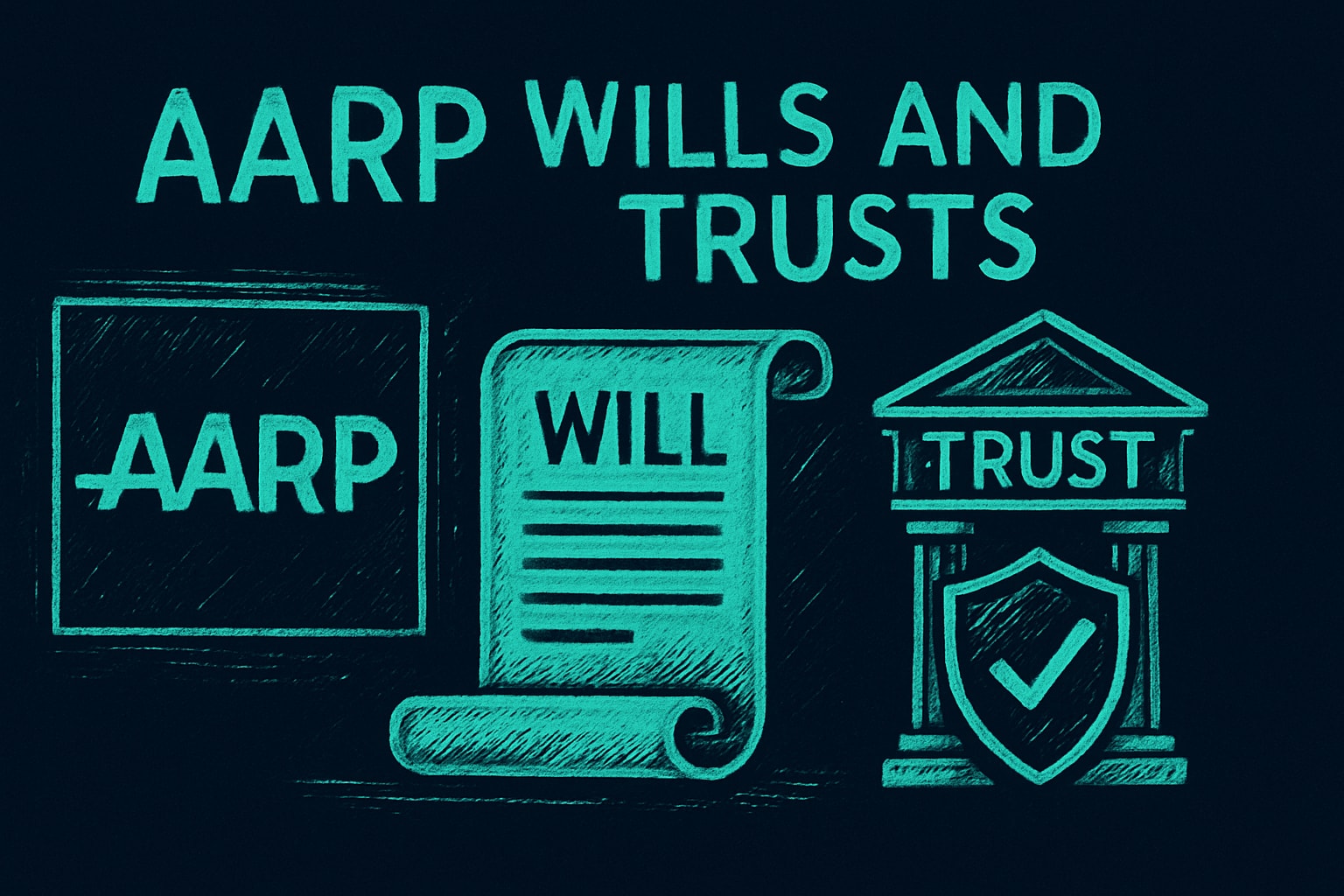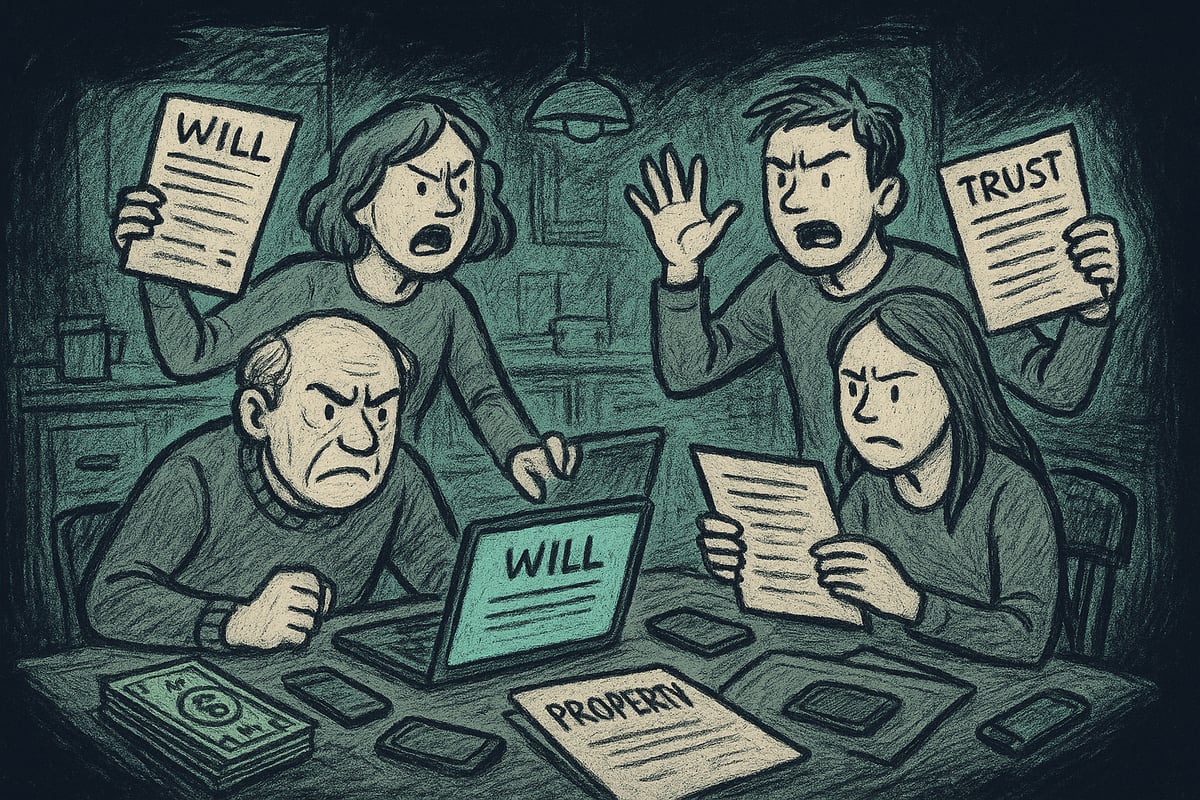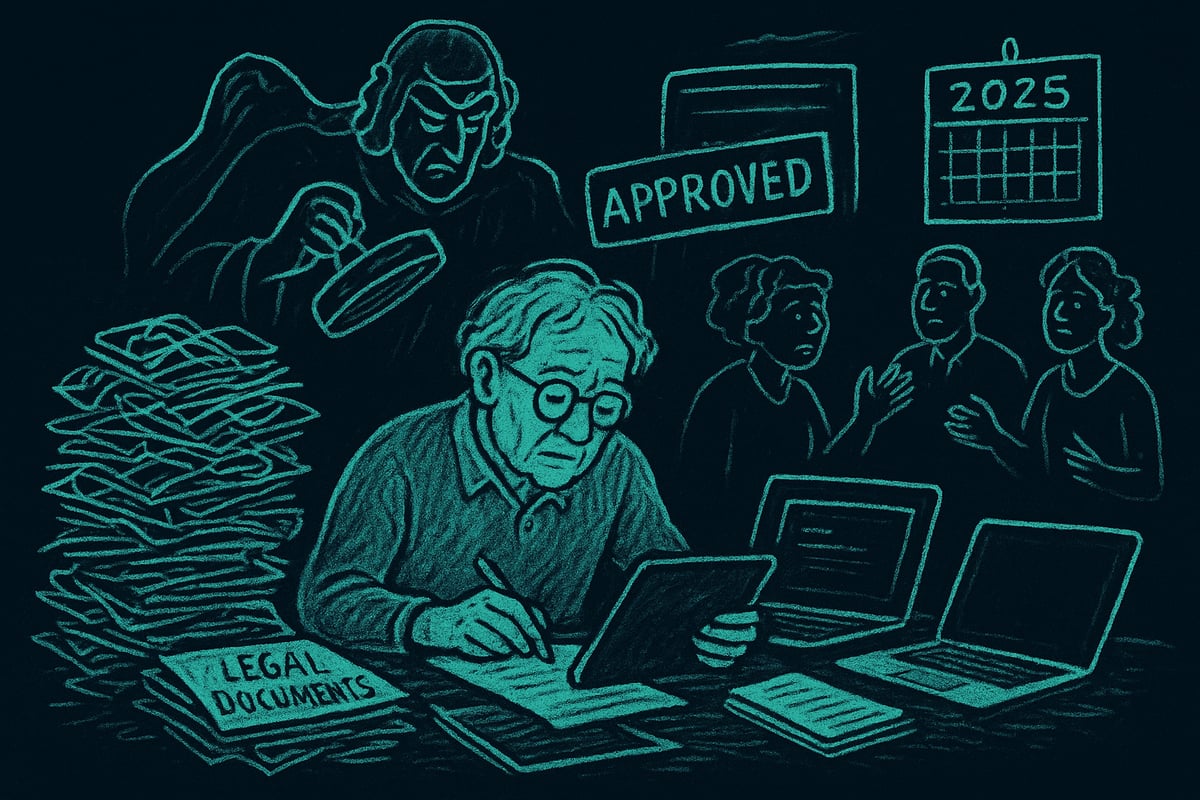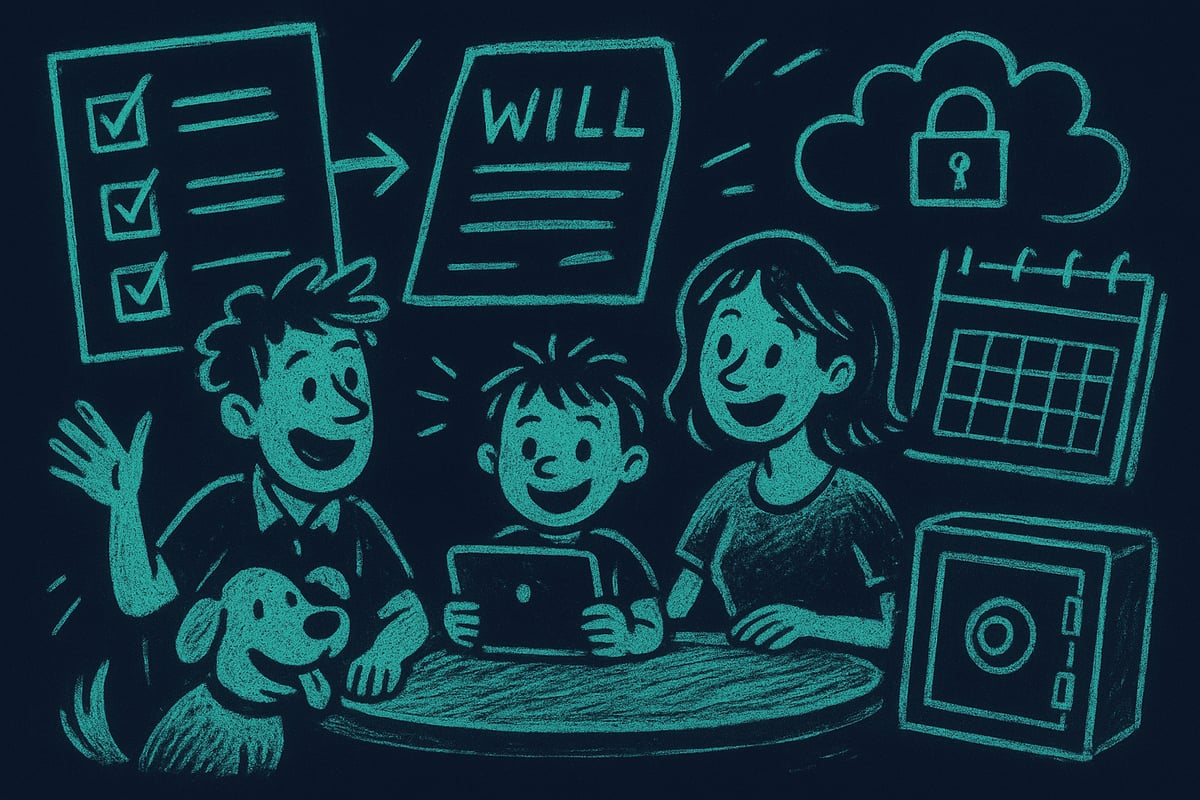AARP Wills and Trusts Guide: Essential Insights for 2025

You’re going to die. Sorry, but someone has to say it. If you think your family will just “figure it out,” let’s talk reality: without proper estate planning, chaos rules. Over 60% of Americans still don’t have a will, and the results? Expensive court battles, sibling cage matches, and your stuff in the wrong hands. This guide to aarp wills and trusts is here to save you from that fate and help you protect your legacy before it’s too late.
We’ll break down the basics, the latest legal curveballs, common mistakes, and step-by-step instructions—no lawyer-speak or guilt trips. By the end, you’ll see how easy it is to take control and make sure your PlayStation (or your house) lands with the right person. Ready to start planning your death party? Let’s go.
Understanding Wills and Trusts: The Basics for 2025
Let’s be real: You’re going to die. (Surprise!) Your family shouldn’t have to turn Thanksgiving into a cage match over your stuff. If you’re still cruising through life without a plan, you’re in the majority. Over 60% of Americans haven’t even bothered with a will, according to recent surveys. Welcome to the club of future probate disasters. This section will roast you into responsibility by breaking down the basics of aarp wills and trusts so you can stop procrastinating and start planning your death party.

What Is a Will?
A will is your last set of instructions for the world—a legally binding love note (or revenge plot) for your heirs. It tells the court who gets your stuff, from the house to your sock collection. No will? The state gets to freestyle, following intestacy laws that rarely care about your complicated family drama.
To count as valid in 2025, your will needs to be in writing, signed, and witnessed—because nothing says “final wishes” like paperwork and two people watching you scribble. AARP wills and trusts advice is clear: If you’re over 50 and still winging it, you’re flirting with disaster. Just ask the families who end up in epic, years-long court battles because Grandpa “meant to get around to it.” Don’t be that ghost.
What Is a Trust?
A trust is like a will’s overachieving sibling. It’s a legal arrangement where you hand off your assets to a trustee, who manages them for your chosen beneficiaries. There are all kinds: revocable trusts (you’re still the boss until you croak), irrevocable trusts (no take-backs), and living trusts (set up while you’re alive, because planning from the grave is a bit late).
Why bother? Trusts can skip probate, keeping your business private and your heirs from waiting years for a payout. The aarp wills and trusts crowd especially loves living trusts for avoiding court delays. Picture this: You pass away, and instead of your family camping out in a courthouse, the trust quietly hands out your legacy like a well-oiled vending machine.
Key Differences and When to Use Each
Let’s pit wills against trusts, gladiator style. Wills are simple, cheap, and public. Trusts are more complicated, cost more, but offer privacy and speed. If you’re single, own a car and a cat, and hate paperwork, a will might be enough. If you’ve got property in other states, a blended family, or a child who can’t manage money, a trust is your new best friend.
Here’s a cheat sheet:
| Feature | Will | Trust |
|---|---|---|
| Goes through probate? | Yes | No (usually) |
| Public record? | Yes | No |
| When effective? | After death | During life and after |
| Cost/Complexity? | Low | Higher |
AARP wills and trusts experts suggest combining both for airtight planning, especially if your family tree looks like a bramble bush. For blended families, special needs kids, or out-of-state property, layering a trust on top of a will is the adult move. Want more than just this snarky table? Check out AARP’s Estate Planning Tools and Workshops for actual templates, checklists, and workshops that make the process less painful.
Congrats! By reading this, you’re already slightly less irresponsible than you were 10 minutes ago. Keep going—your heirs will thank you.
Recent Legal Updates and Trends Impacting Estate Planning
Forget the Grim Reaper for a second—the real threat to your legacy is legislative whiplash. Every year, the rules around wills and trusts get more complicated, and 2025 is no exception. If you think aarp wills and trusts advice is just for “old people,” think again. The law does not care how cool you think you are; it will eat your estate for breakfast if you are unprepared.

2025 Legislative Changes and What They Mean
Welcome to 2025, where the only thing more confusing than TikTok is estate law. Congress and state legislatures have been busy tweaking the rules on aarp wills and trusts, making your procrastination even riskier. If you have not heard, the “One Big Beautiful Bill” (OBBB) changed everything from estate tax exemptions to how digital wills are validated. Curious how this legislative monster could impact your assets or your ex’s shot at your vintage comic book collection? Check out this deep dive on the Impact of the One Big Beautiful Bill on Estate Planning.
States like Utah are now letting you sign wills from your couch—remotely, with a webcam and digital notary. No more awkward trips to a law office. But beware, not every state plays by the same rules. AARP keeps fighting for elder rights and less red tape, but if you snooze, your heirs might lose. The bottom line? Staying up to date with aarp wills and trusts advice could save your family from a paperwork nightmare.
Demographic Shifts and Family Structures
Remember when “family” just meant Mom, Dad, and 2.5 kids? Not anymore. Over 40% of Americans are now in non-nuclear setups—think blended families, unmarried partners, and multi-generational chaos. This makes aarp wills and trusts planning more like assembling IKEA furniture: there are extra parts, missing instructions, and someone is always left out.
Your stepkids, your long-term partner, or your TikTok-famous grandchild could all be at risk of getting nothing if you do not plan ahead. AARP has rolled out resources for every kind of modern family, so you can avoid ugly surprises and keep the peace—even if your family tree looks more like a bramble bush.
The Impact of Technology on Estate Planning
If you are still storing your will under the mattress, congratulations on living in 1952. These days, aarp wills and trusts are going digital. Online platforms promise fast, cheap, and “lawyer-free” document creation. Sounds great, right? Well, yes—and no.
Digital estate planning is convenient, but it is also a minefield. Miss one legal requirement, and your will could be as worthless as a MySpace password. AARP says: use tech, but do not trust every shiny website. We have all seen DIY disasters—like the guy who left his Bitcoin to his cat because he clicked the wrong box. When in doubt, get professional help or at least double-check your digital documents. Your legacy deserves better than a tragic punchline.
Step-by-Step Guide: Creating Your Will or Trust in 2025
If you’re reading this, congrats. You’re already doing more than most Americans who think “estate planning” is something only rich people do. Spoiler: If you own a couch, a cat, or a cryptic Bitcoin wallet, you have an estate. Let’s walk through the not-so-glamorous, but absolutely essential, steps to putting your aarp wills and trusts game face on for 2025.

Step 1: Assess Your Estate and Family Needs
First things first, take a hard look at your “stuff.” That means every asset, from your house to those embarrassing photos in your cloud storage. Don’t forget digital accounts, investments, or the vinyl collection you swear is worth a fortune.
Make a list of the people (and pets) who might actually want your leftovers when you’re gone. Got dependents, special needs family, or debts lurking in the shadows? Jot those down. AARP wills and trusts resources offer a checklist so you don’t accidentally leave your favorite child out.
- List all physical and digital assets
- Identify heirs, including minors and fur babies
- Note debts, mortgages, and obligations
The more thorough you are now, the fewer surprise family feuds later.
Step 2: Decide Between a Will, a Trust, or Both
Here’s where you choose your weapon. Wills are simple, cheap, and fine for basic situations. Trusts are like the Swiss Army knife for the control freaks among us: more privacy, skip probate, and better for complex families or assets in multiple states.
| Tool | Best For | Privacy | Probate | Cost |
|---|---|---|---|---|
| Will | Simple estates, single home | Low | Yes | $ |
| Trust | Blended families, out-of-state property | High | No | $$ |
AARP wills and trusts guidance offers a decision tree if you’re lost. If your estate is straightforward, a will is probably enough. If you’re hiding a vacation home or a tricky family tree, a trust may save everyone a headache.
Step 3: Drafting Your Documents
Channel your inner lawyer or, better yet, don’t. You can use an attorney, an online service, or a DIY kit, but beware: a poorly executed will is as useful as a chocolate teapot. In 2025, you’ll need the right witnesses, notarization, and maybe even a digital signature, depending on your state.
AARP wills and trusts experts see plenty of people trip up here. Want to avoid being a cautionary tale? Check out Common Estate Planning Mistakes to Avoid before you sign anything.
- Use reputable services or legal help
- Double-check state requirements for validity
- Don’t forget to update your documents if your life changes
One wrong move and your PlayStation ends up with your least favorite cousin.
Step 4: Update and Store Your Documents Securely
Great, you’ve got a plan. Now, don’t just toss it in the junk drawer. Update your aarp wills and trusts documents after every major life event: divorce, remarriage, new baby, or when your dog learns to use the internet.
Store originals in a fireproof safe, and back up digitally with secure password protection. Tell your executor where to find everything, or your family will be hunting for clues like a bad escape room.
- Keep copies with trusted people
- Use secure cloud storage
- Review your plan every 2–3 years
Step 5: Communicate Your Wishes
Time to sit the family down for the world’s most awkward dinner conversation. Explain your aarp wills and trusts decisions so no one is surprised when you’re haunting the attic. Use AARP’s conversation guides if you need help breaking the ice.
Talking now saves your loved ones from drama later. Plus, it’s your last shot at being the center of attention.
Common Pitfalls and How to Avoid Them
Congratulations, you’ve made it to the part where we roast your procrastination. You know, the part where unfinished business haunts your family like a bad ghost story. Let’s break down the most common mistakes people make with aarp wills and trusts, so you don’t end up as a cautionary tale whispered at Thanksgiving.

Overlooking Key Assets or Beneficiaries
Let’s be real. Most people think if they scribble “Give house to kids” on a napkin, they’re done. Nope. Overlooking assets like digital accounts, out-of-state property, or even your secret crypto stash is the fast track to a family feud. Don’t forget minor children or that pet iguana, either.
- Commonly missed: online subscriptions, forgotten bank accounts, and 401(k)s from that job you hated.
- Real talk: One client’s family spent months fighting over a forgotten vacation home. Spoiler alert: no one got to enjoy it.
AARP wills and trusts experts urge you to list everything, yes, even your embarrassing email handles. For more on securing your digital assets, check out Digital Will Management Solutions for innovative, cross-platform approaches.
Failing to Update Documents
So, you made a will in 1999. Congrats! Too bad you’ve since divorced, remarried, and acquired three new grandkids. Outdated aarp wills and trusts are like expired milk—unpleasant surprises guaranteed.
- 30 percent of wills are out-of-date when someone dies.
- Major life changes require updates: marriage, divorce, new heirs, or moving to another state.
AARP reminds you to review your documents every couple of years. It’s not rocket science, but it does keep your ex from inheriting your prized PlayStation.
DIY Dangers: When to Seek Professional Help
If you think downloading a free template is the secret to estate planning, think again. DIY aarp wills and trusts can backfire faster than you can say “probate court.” Common blunders include forgetting witnesses, misnaming heirs, or using the wrong state’s laws.
- Complex families? Special needs? Out-of-state property? Call a professional.
- AARP offers a checklist for when you need legal muscle.
Bottom line: If your life is messier than a reality TV reunion, don’t wing it. Get help.
Affordable Online Solutions for Estate Planning
The good news: Modern online platforms make creating aarp wills and trusts less painful than a root canal. These services offer clear steps, digital storage, and reminders to update your documents—often at a fraction of a lawyer’s bill.
- Look for: plain language, security features, and transparent pricing.
- AARP suggests vetting platforms for legal compliance in your state.
Bottom line: You don’t have to be a tech genius to plan for the inevitable. Affordable, reliable options mean you can spend more on your death party and less on legal bills.
Resources and Support from AARP and Beyond
Facing your own mortality is fun, right? Well, at least AARP makes it less painful with a smorgasbord of resources. If you’re tired of pretending you’ll “get to it next year,” this is your one-stop shop to get off the procrastination train and actually do something about your estate planning. Let’s see how not to leave a legal circus behind for your loved ones.
AARP’s Estate Planning Tools and Workshops
Ready to graduate from “I’ll get to it eventually” to “Look at me, responsible adult”? AARP offers free guides, checklists, and webinars designed to drag you—sometimes kicking and screaming—into the world of aarp wills and trusts.
- Access downloadable templates to start your will or trust
- Join live Q&A sessions with experts who have seen every flavor of family drama
- Attend local workshops (yes, you’ll have to leave the house, but snacks may be provided)
Members have shared their success stories, usually involving less yelling at Thanksgiving. With these tools, you can finally write “estate plan” on your to-do list and actually cross it off.
Finding Qualified Professionals
If you think Google can replace an actual estate planning attorney, think again. AARP cuts through the legal mumbo jumbo with vetted referral networks and tips to help you avoid sharks posing as “experts” in aarp wills and trusts.
- Use AARP’s directory to find attorneys and advisors who won’t ghost you
- Look for credentials, not just a fancy office or an expensive pen
- Watch for red flags (like anyone promising to “hide your assets from aliens”)
AARP’s vetting criteria keep you from falling for the legal equivalent of a get-rich-quick scheme. Do yourself a favor and get advice from someone who knows the difference between a will and a napkin doodle.
Online Platforms and Digital Resources
Let’s face it, you shop for toilet paper online, so why not your will? The digital age means you can tackle aarp wills and trusts from your couch, in pajamas, while ignoring your family’s pleas for dinner.
- Compare reputable online will and trust services in the handy table below
- Learn AARP’s best practices for digital security and safe document storage
- Evaluate features, pricing, and user reviews without talking to a single human (unless you want to)
| Platform | Cost | Features | User Experience |
|---|---|---|---|
| Killswitch | $69 | Fast, plain English | Quick, simple |
| LegalZoom | $89+ | Customizable options | Guided, step-by-step |
| Trust & Will | $159+ | Attorney support | Modern, intuitive |
AARP keeps you from falling into the DIY trap without a parachute, so you can go digital without your heirs needing a tech support hotline.
Community Support and Continuing Education
Still not convinced you need aarp wills and trusts? Join the club—literally. AARP’s forums and support groups are packed with people who started out as procrastinators and ended up as estate-planning superheroes.
- Engage in peer advice and share “my family is crazier than yours” stories
- Stay sharp with newsletters and legal updates that won’t put you to sleep
- Take advantage of continuing education, because apparently, you’re never too old to learn how not to mess this up
With these resources, you can keep your legacy intact and maybe, just maybe, avoid starring in your own episode of “Estate Nightmares: Family Edition.”
Look, we both know “I’ll get to it later” is your middle name—and that’s exactly how families end up feuding over Grandma’s ceramic cat collection and your secret crypto wallet. You’ve made it this far through the AARP wills and trusts guide, so why not actually do the responsible thing for once? Death is free, but making sure your ex doesn’t inherit your PlayStation costs just $69 and about half an hour of your life (while you’re still alive, no less). Save your loved ones from chaos and courtrooms—Start My Will Now.